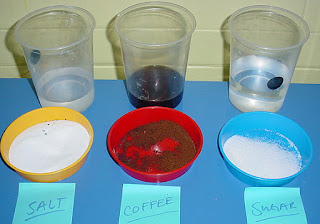Lesson Plan of Soluble & Insoluble Solids General Science Grade IV
Lesson Plan of Soluble & Insoluble Solids
General Science Grade IV
Students’ Learning Outcomes
·
Explain how one state of
matter (solid, liquid & gas) dissolves in other.
Information for Teachers
 ·
Common salt and sugar when
added in water disappear to give mixtures. This is called dissolving a solid
into liquid.
·
Common salt and sugar when
added in water disappear to give mixtures. This is called dissolving a solid
into liquid.
·
Similarly a gas (CO2) can also dissolve in liquid water, like soda
water/cold drink.
·
The materials that dissolve
in water are called soluble materials. The materials that don’t dissolve in
water are called insoluble materials. Glucose and salt are soluble materials.
Material / Resources
Water, sugar, glass, spoon,
common salt, chalk powder, soil, glucose, lemon juice and vinegar, textbook
Worm up activity
·
Half fill the glass with
water and add a spoon full of sugar in it. Stir it with a spoon.
·
Ask the students: What
happens to the sugar? Where is it gone? Can you see it? Explain them that it
has dissolved in water.
·
Ask students to taste the
liquid. How does the liquid taste?
·
Name the mixture obtained in
the above activity?
(Students’ response:
Solution)
·
Which two states of matter
make the solution formed in this activity?
(Students’ response: Solid
and Liquid)
Development
Activity 1
·
Divide the students in groups
and give each group the following substances and ask them to add one by one in
water (Common salt, Chalk powder, Glucose, Sand)
·
Ask the students to tick the
names of the solid things which dissolve / disappear in water like the way
sugar dissolves. (Common salt, Glucose)
·
What about the rest of the
substances?
·
Explain them that when
substances are mixed in water some of them mix up with water and disappear we
say that they have dissolved. Others don’t dissolve. The materials that
dissolve in water are called soluble materials. The materials that don’t dissolve
in water are called insoluble materials. Glucose and salt are soluble
materials.
Activity 2
v What comes out of water in the form of bubbles?
(Students’ response: CO2, a gas)
v How does soda water taste?
(Students’ response: It tastes sour)
v Soda water is a mixture of which states of
matter?
(Students’ response: liquid, gas, sugar which
is a solid)
Point out that soda water is a mixture of all
three states of matter.
Activity 3
·
Divide students in small groups.
Give the material and instruct them to:
·
Take water in one glass and
lemon juice in another glass.
·
Mix the two liquids.
·
Ask the students to answer
following questions:
(Students’ response: They dissolve in each
other)
v What is the name of the mixture you get after
mixing the above two liquids?
(Students’ response: Solution)
Sum up / Conclusion
·
There are certain things
which disappear when added in water. We say that these things dissolve in
water.
·
Soda water is an example of
such a solution in which a solid (common sugar) and a gas (carbon dioxide) are
dissolved in water (liquid)
·
A liquid can also dissolve in
another liquid. Inform them that next time we will study how insoluble
materials are separated from water.
Assessment
Ask students to:
v Name any two liquids which mix with water like
the way lemon juice mixes with water.
(Students’ response: a) Honey b) Vinegar)
v Name any two liquids which don’t mix with water
and form separate layers.
(Students’ response: a) Kerosene oil b) Cooking oil)
v Animals like fishes can’t live without oxygen. From
where do they get oxygen in water?
(Students’ response: Some oxygen from air is
dissolved in water. Fishes breathe using the oxygen dissolved in water)
v Write the following things on board and as which
of these can dissolve in water and which can’t? They can conduct experiments to
find the answer.
v Honey, Kerosene oil, petrol, vinegar, marble
chips (stones), urea fertilizer, sand.
(Students’ response: Things which don’t mix
with water are: Kerosene oil, petrol, marble chips and things which mix in
water are: Honey, Vinegar and urea fertilizer)
Follow up
·
Write these questions on the
board and ask them to note down on their note books.
v What is air? Is it a mixture?
(Students’ response: Air is a
mixture of nitrogen, oxygen, carbon dioxide and water vapors)
v Sea water is a solution of which states of
matter?





Comments
Post a Comment